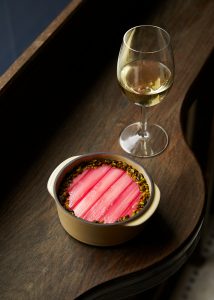Port discovers the botanicals, stills and Thomas Heatherwick-designed greenhouses at Bombay Sapphire’s Hampshire distillery

Gin can be said to lack the imaginative associations, the romanticism, of other drinks. Whiskey comes heavy with images of ageing barrels, dimly lit and earthy. Wine is vineyards and sun, French countryside in a grape. Even vodka has a form of romance in a cold, Russian sense. But where vodka is essentially a blank canvas, gin is expressive.
Sam Carter, who oversees the Laverstoke distillery – a former Victorian paper mill and the home of Bombay Sapphire – talks of gin providing a greater drinking ‘experience’ than vodka. Carter helped design the distillery and now works developing gins, such as the Star of Bombay, as well as crafting signature cocktails.
“One of the main things I love about gin production,” Carter told me when I visited Laverstoke, “is not only the variation in the different botanicals (herbs, roots, spices, flowers, plants, nuts, etc.) you can use to make gin, but also the choice of base alcohol used, the water and the different physical production processes… like grapes in wine, botanicals can be effected by terroir, rain, wind, sun, shade, drainage.”

Gin is, in essence, alcohol flavoured with juniper and other botanicals – classically in the proportions of 40% juniper, 40% coriander seeds, 10% liquorice root and 10% angelica root – but there is a world of potentiality. From Bombay Sapphire’s original 1761 recipe’s eight botanicals, through to Star of Bombay’s twelve, it is clear that that the choice and quantities of these ingredients can have a considerable effect on the outcome.
There is Angelica root, which Carter described as tasting like a forest after the rain, which holds and binds the flavours together. The exotically named Grains of Paradise – tiny seeds that are part of the ginger family, which change flavour as you taste them, slowly releasing a building heat. Then there is the bone-like Orris root, which takes four years to grow and four to dry, and is solid, feeling more like an artefact than any part of a plant. In addition, almonds are included for texture, giving the gin a creamy consistency that allows it to sit smoothly on the tongue. Each is a vital, complementary part.

I asked Carter about the process that goes into choosing these parts, these moving components. “You have to focus on the flavour a botanical provides – flavour is made up of nasal aroma, retro nasal aroma, taste, trigeminal effect and aftertaste – and can I balance its flavour with the other botanicals. In gin, balance is king. Our Bombay Sapphire gin isn’t one dimensional, it tastes floral, citrusy, rooty, piney and spicy. The flavours are layered to give a length of flavour.”
Carter and Ivano Tonutti, the Master of Botanicals, put this into practice when they created Star of Bombay. They worked to make something with more depth and more easily drank straight. Ambrette seeds, small snail-like things, which taste almost of monkey-nut, were added to bring more creaminess. Spanish Bergamot peel, dried by hanging from lines outside, brings a deeper citrus flavour. They slowed down the distillation process, allowed less yield. It’s as you taste the new depth this allows, the way it sits in the mouth, that you realise the malleability of the distillation process, how its built out of these relationships between botanicals, re-orientating itself and re-shaping its flavour as new ones are introduced to one another.

There are examples of all of the botanicals used alive and growing at Laverstoke distillery. Nestled amidst the converted paper mill are the twin greenhouses designed by Thomas Heatherwick, the architect and designer also responsible for the new Routemaster-inspired London busses, the 2012 Olympic velodrome, and the ultimately unsuccessful design for the ‘Garden Bridge’ Thames crossing. Inspired by Victorian glasshouses, the greenhouses are made up of over 700 individual panes of glass curving out of the River Test, woven by the metal frames into the old paper mill. Each is their own microclimate, one showcasing the botanicals based around the Mediterranean climate – cool and floral – and the other tropical, humid and heavy.
This close interaction with botanicals is key to the way Bombay Sapphire distils their gins, and they are the only London Dry Gin to be 100% vapour infused. Many gins a produced by steeping, a process by which the alcohol, water and botanicals are combined in a still and boiled together. With this method, the heat pushes the botanicals to the top and to the sides of the copper still where, in contact with the hot metal, the sugars caramelise, almost cooking.

At Laverstoke, the botanicals are on the opposite side of the room to the alcohol, which is heated and travels as vapour to rise up through the botanicals, collecting their flavour without cooking them, before condensing back to a liquid. In this way, part of the original organic form of the botanicals are preserved in the final flavour of the gin and they are not de-natured. It’s a method that allows not only the natural flavours to come through but allows a delicacy to the different shades of those flavours that traditional distillation methods don’t.
What’s apparent walking around Laverstoke is that this is a live process. The vapour infusion has properly started when the citrusy notes start to come through, and the other flavourings arrive on cue like clockwork, as each botanical is gently activated in turn, until they become tired and you can detect an over-cooked ‘biscuit-note’.
Yet at the same time as you can smell its progress, there is a feeling of absolute precision, of everything being monitored, down to the humidity and natural oils of of the botanicals. It feels at once organic and industrial, both live and controlled.




